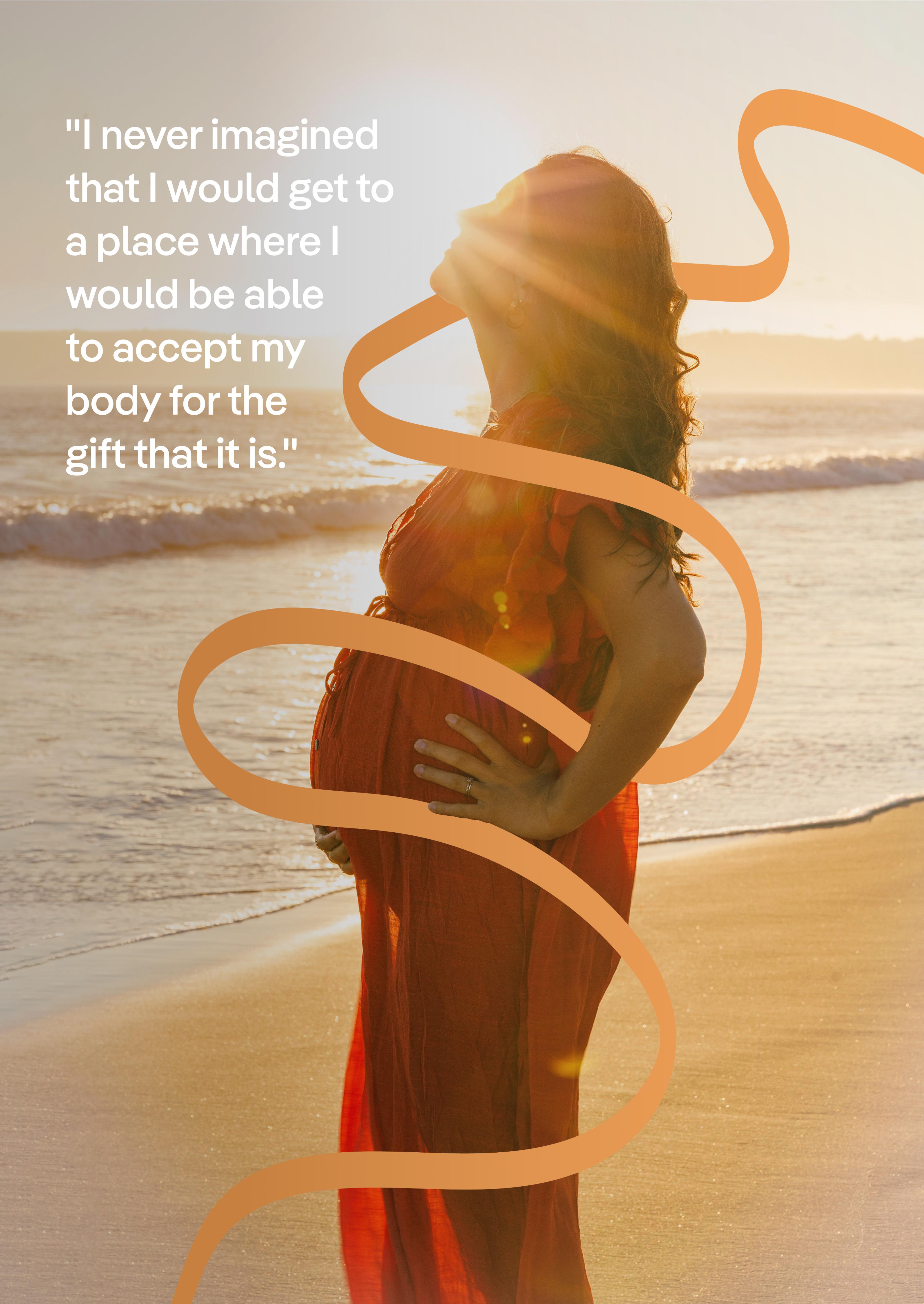


I’ll never forget the moment I saw my postpartum body for the first time. It was mid-morning, several hours after I’d given birth to my daughter, when I finally made my way from the hospital bed to the small bathroom and was taken aback by my reflection. The big, firm belly where my baby had lived was gone, replaced by loose skin that flopped over disposable hospital underwear; my breasts had swollen to a size I’d never seen before; even my arms and legs looked different: softer, weaker, bigger. I’d been prepared for the bodily changes of pregnancy, but it wasn’t until that very moment that I’d considered my post-birth body. Staring at my exhausted reflection—emotionally and physically overwhelmed by the whole business of childbirth, not having slept in nearly 36 hours—I had an inkling of a thought: this new body might be a problem for me.
I’m in recovery from anorexia, and knew that pregnancy could present the opportunity for eating disorder thoughts and behaviors to resurface (luckily for me, they hadn’t). But, as I would soon learn, the postpartum period was a whole different animal, with arguably greater risk for those in recovery from or vulnerable to eating disorders. Ultimately, I made it through okay, with some hiccups along the way. But had I understood the contours of postpartum eating disorders—and what to do to protect myself and my recovery–it would have been made for a smoother, less fraught transition. And I’m far from alone in this experience.
How common are postpartum eating disorders?
As a whole, research suggests that the postpartum period is a high-risk time for eating disorders. Depending on which study you look at, the rate of eating disorders among those who have recently given birth is up to 13%, as compared to about 5% for pregnant people (and a baseline rate of 9%). And for those who self-reported more eating disorder thoughts and behaviors before becoming pregnant, the risk of disordered behaviors in the postpartum period becomes even greater.
It’s important to note that the research here is still somewhat limited. While clinical studies suggest that the postpartum period is a high-risk time for the recurrence of anorexia and bulimia, there are gaps in our knowledge. For instance, not much is known about the recurrence of other eating disorders, like OSFED or binge eating disorder, during the postpartum period, nor the prevalence of net-new eating disorders after giving birth.
Still, these numbers are sobering, and an indication that we need to pay closer attention to this brief but consequential period of life. As one paper put it, “seriously disordered behavior during, and especially after, pregnancy may be more common than previously thought.”

Eating disorders in pregnancy vs. the postpartum period
Equip Senior Research Manager Jessica Baker, PhD, explains that most of the existing research compares postpartum eating disorders to eating disorders during pregnancy (sometimes referred to as 'pregorexia') rather than pre-pregnancy, and so that’s where we must look to draw any conclusions (at least for now). This body of research, she says, has largely found that for women with anorexia and bulimia, pregnancy leads to a remission of eating disorder symptoms—in one particular study that she cites, 75% of women reported no symptoms by the third trimester. Indeed, while some eating disorder symptoms (like binge eating) can increase during pregnancy, they generally diminish during those nine months.
“However,” Baker says, “for the majority, these symptoms return during the postpartum period.” Most studies show that while eating disorder attitudes and behaviors—like restricting, purging, and weight concerns—decrease throughout pregnancy, this reprieve tends to be followed by a backlash. Post-birth, eating disorder symptoms return to baseline levels, or may even be more intense. For me, I saw this exact dynamic play out in my own mind: throughout pregnancy, any lingering body image distress or food anxiety disappeared, only to return with a vengeance once my daughter was outside my body.
Read: Can Pregnancy Trigger an Eating Disorder?
Why the postpartum period is such a high-risk time for eating disorders
So why, exactly, do eating disorder symptoms tend to spike during the postpartum period? There’s not one answer, but rather a confluence of different factors that can create, for some, a perfect storm for an eating disorder to surface or resurface.
“Bounce back” culture
Society puts many demands on new mothers, but one is louder and clearer than others: your body should look like you never had a baby. And fast. This pressure is almost universally felt—according to one study, 75% of women are concerned with weight retention in the first month after delivery, and 70% are attempting to lose weight by four months postpartum—but it can be particularly pronounced for people in eating disorder recovery. After delivery, those with an eating disorder history may struggle more intensely with pregnancy-related weight gain and a desire to lose weight, setting themselves up for disordered eating and rigid food rules that can lead to a relapse.
“The drive to be that old you, to have the same old body, can fuel disordered eating behaviors,” says Equip dietitian Stephanie Kile, RD. “Having an eating disorder in my past, I was worried that the urge to ‘bounce back’ would set in, and that seeking the praise of comments like ‘you don’t look like you had a baby!’ would make my eating disorder flare up.”
Baker emphasizes the potentially harmful influence of societal pressures, explaining that “physically, post-birth, people experience fluctuations in weight and changes in body shape that don’t align with the thin ideal. One of the most consistent and potent risk factors for an eating disorder is body dissatisfaction, and reports suggest that about 50% of people are dissatisfied with their weight postpartum.”
Coming to terms with an unfamiliar body
Even putting aside a desire to lose weight and pressure to attain certain body ideals, many people are uncomfortable with their postpartum body simply because it’s completely unfamiliar. I know I felt that way—as if I was looking at someone else’s body when I looked in the mirror.
Molly Menton, VP of Clinical Operations at Equip, describes a similar experience: “By the time I got pregnant with my twins, I’d been in recovery for a good 15 years and was really comfortable in my skin. I was excited about pregnancy and not concerned about the weight gain. But the postpartum period was challenging because I expected my body to feel the same as it used to pre-pregnancy, but it didn’t. It felt softer, spongey, loose, and my joints were like jelly. I couldn’t move in the same way that I used to, my bladder didn’t work anymore, and my breasts were giant and leaky. It felt like an entirely new and different body. I thought weight gain would be the ‘thing’ that was hard about the postpartum period, but the hardest part was how different and foreign my body felt. I didn’t recognize my body, not just size and weight but composition, capabilities, and tolerance. I had new pains and aches that I’d never had before, my endurance was low, and it felt like nothing worked right anymore. I had no idea how long this period would last. Would I ever go back to my old body? Would things ever feel normal again?”
Postpartum depression
Research shows that people with eating disorders have an elevated risk of developing postpartum depression or anxiety—according to one study, up to 50% of those with an eating disorder history experience postpartum depression.
This plays into postpartum eating disorders because eating disorder behaviors can serve to regulate negative mood and emotions. In other words, when a woman experiences depression after giving birth, she may use behaviors like restricting or purging as a coping mechanism, raising her risk of developing or relapsing into a full-blown eating disorder.
Psychological stress
It’s not a secret that parenting a newborn is hard. On top of recovering physically from labor and delivery, there are sleepless nights, never-ending diaper changes, and crying bouts that you can’t seem to stop or understand. And beyond those immediate demands, there are more nebulous and even existential concerns: who are you, now that you’ve had a child? What does your relationship with your partner look like? Will you be a good parent? What does being a good parent even mean?
These questions and concerns are a heavy weight to carry (especially when you’re running on little to no sleep), and, again, the eating disorder can come to the rescue. For those in recovery, it may be tempting to return to behaviors that you know help turn down intense emotions. I remember breastfeeding after a particularly long night, feeling exhausted and irritated at my husband for some long-forgotten reason, and finding comfort in the simple act of opening up MyFitnessPal to log the foods I’d eaten that day. Though I knew how harmful that behavior could be for me, it allowed me to temporarily escape from my emotional and physical distress. This, ultimately, was a blip for me, and not the first step on the road to relapse, but it clearly illustrates how that road is paved.
Hormonal shifts
Baker explains that hormones play an important role in the fluctuations of eating disorder symptoms during pregnancy and the postpartum period. “During pregnancy, estrogen and progesterone concentrations progressively increase until childbirth, and both hormones abruptly decrease postpartum,” she says. She goes on to explain that research in non-pregnant women has established a strong relationship between ovarian hormones and eating disorder symptoms, showing that the higher someone’s estrogen levels, the lower their eating disorder symptoms (this is particularly true of binge eating).
This pattern parallels what’s been observed in pregnant and postpartum samples: as estrogen increases, eating disorder symptoms decrease; and when those levels plummet after childbirth, the symptoms come roaring back. “It makes logical sense that ovarian hormones are involved in the development of disordered eating behaviors, given that decades of animal study research has established that estrogen plays a role in ‘normal’ food intake,” Baker says.
Of course, this doesn’t happen to every person who becomes pregnant: it’s thought that a certain subset of biological females may be more sensitive to changes in ovarian hormones, and that this subset overlaps with those who have an eating disorder history or are at risk for developing an eating disorder.
Breastfeeding
For many, breastfeeding is a big part of the postpartum experience. And while it can be deeply rewarding and meaningful for some, it can be incredibly difficult for others—and it presents its own risks for eating disorder onset or relapse.
Perhaps most notably, our culture likes to present breastfeeding as an effective way to lose weight after pregnancy (a claim based on the fact that it takes a lot of calories to produce breast milk). Not only does this mentality reduce a special bonding experience to a weight loss gimmick, but it can also lead down a road to disordered behaviors and negatively impact a person’s ability to breastfeed in the first place. “The idea that breastfeeding will help you lose weight isn’t entirely true due to the increased nutrition needed to help milk production. Plus, the body tends to hold onto some weight to make sure you can continue to produce milk safely—think of it as a reserve for the body to dip into in case of emergency,” says Kile. “Thinking of breastfeeding as a means to weight loss can open the door for an eating disorder postpartum. The eating disorder will want to lose weight on a quick timeline, which isn’t always compatible with breastfeeding. You need adequate nutritional intake from a variety of nutrients to make sure milk composition is what it needs to be for the baby; if intake is too low, it could negatively impact milk supply.”
Research seems to bear this out, showing that mothers with a history of anorexia were more likely to stop breastfeeding before six months postpartum—and while this may be for a variety of different reasons, inadequate milk supply is a likely culprit. This was the case with me. While I had no problem meeting my nutritional needs while pregnant, I struggled to meet my high caloric demands while breastfeeding (I remember that little eating disorder voice, having been quiet for so many years, telling me that I didn’t have an “excuse” anymore, because the baby was no longer inside my body). As my food intake dwindled, so did my milk supply. I’d set a goal of breastfeeding for one year: by five months, I needed to supplement with formula; by eight months, I stopped breastfeeding completely.
It’s important to note that someone’s choice about whether or not to breastfeed is theirs and theirs alone. Nobody should feel guilt for not breastfeeding, whether it’s by choice or otherwise. However, for those who do want to breastfeed, it’s important to understand the impact that disordered eating can have on the physiological process.
How to protect against postpartum eating disorders
Eating disorder relapse is by no means inevitable during the postpartum period—but it’s vital to acknowledge that this is a high risk time for those with an eating disorder history, as well as those who may be vulnerable to a new onset eating disorder. Thankfully, there are things you can do to bolster against the risks and keep eating disorder thoughts at bay after giving birth:
- Remember that your body just went through a significant ordeal. No matter how your labor and delivery goes, childbirth is, in many ways, a massive physical trauma, and your body deserves both gratitude and grace afterward. “The body needs time to heal. The placenta leaves behind a wound the size of a dinner plate. Your organs need to move back into place, the uterus needs to shrink, and all of that takes proper nutrition to make sure your body is fueled to properly heal,” says Kile. “Give yourself permission to eat, and eat often. Your body just went through a huge change.”
- Make yourself comfortable. We mean this literally: don’t race to get into pre-pregnancy clothing, or squeeze yourself into items that just barely fit. Continue to wear your maternity clothes if you need to, and focus on what lets your body feel good during this physically taxing time. “Find comfortable clothes, ease back into movement, and accept that your body feels different because it is different: you built a baby!” says Menton.
- Curate your social media. “Bounce back” messages exist everywhere, but social media may be one of the richest sources. Especially if you’ve been flagged by these platforms as a new parent, you’re likely to be inundated with influencers and content centered around losing the baby weight. Silence this noise by muting, unfollowing, or blocking any accounts that make you feel bad about your body.
- Talk to your support network. When you’re spending all your waking moments with a newborn, it’s easy to become isolated from friends, family, and other loved ones. This isolation can allow eating disorder thoughts to grow louder and remain unchallenged—so proactively counteract this risk by sharing your experience with others. “Talk to someone about your struggles, the goals you have in mind, and remind yourself that your journey doesn’t need to look like anyone else’s journey,” says Kile.
- Put the right support team in place. “People with a current or history of an eating disorder should find a licensed provider they’re comfortable sharing this information with, so that they can implement proper monitoring,” advises Baker. “Speak to providers about closed weights. Reconnecting with a previous therapist or dietitian for support throughout pregnancy and postpartum can be useful to develop a plan, work through triggers and stressors, and have an outlet.”
- Be patient with yourself—and your body. “I wanted to get back to my pre-baby weight, but realized that caring for twin newborns, breastfeeding, sleep, and recovering from birth was a Herculean task all on its own,” says Menton. “I intentionally stayed very focused on being patient and letting my body figure out where it would settle after this major milestone.”
These guidelines can make it easier to navigate any eating disorder thoughts or behaviors that may resurface during the postpartum period. But, of course, it’s also possible that these precautions won’t be necessary at all: as research has found, some women with eating disorders during pregnancy actually reach recovery postpartum, reporting that they no longer have the time or desire to engage in eating disorder behaviors, and that they don’t want to negatively influence their children by modeling disordered actions.
While I write this, I’m 37 weeks pregnant with my second child. As with my first pregnancy, I’ve loved watching my body change and grow; but, given where my mind went after my daughter was born, I’m beginning to get nervous about the thoughts that might crop up once the baby is here. This time, though, I know the risks. Having lived through the newborn phase once before, I know how fleeting and precious this time is, and will fiercely protect my ability to be present throughout it, without eating disorder thoughts ripping me out of the moment. Armed with the knowledge and advice above, I’m hopeful that I—and any pregnant or postpartum person who reads this—will be able to do just that.

- Pettersson, C.B., Zandian, M. & Clinton, D. Eating disorder symptoms pre- and postpartum. Arch Womens Ment Health 19, 675–680 (2016). https://doi.org/10.1007/s00737-016-0619-3
- Martínez-Olcina, María et al. “Eating Disorders in Pregnant and Breastfeeding Women: A Systematic Review.” Medicina (Kaunas, Lithuania) vol. 56,7 352. 15 Jul. 2020, doi:10.3390/medicina56070352
- Knoph, Cecilie et al. “Course and predictors of maternal eating disorders in the postpartum period.” The International journal of eating disorders vol. 46,4 (2013): 355-68. doi:10.1002/eat.22088
- Lacey, J H, and G Smith. “Bulimia nervosa. The impact of pregnancy on mother and baby.” The British journal of psychiatry : the journal of mental science vol. 150 (1987): 777-81. doi:10.1192/bjp.150.6.777
- Crow, Scott J et al. “Eating disorder symptoms in pregnancy: a prospective study.” The International journal of eating disorders vol. 41,3 (2008): 277-9. doi:10.1002/eat.20496
- Watson, Hunna J et al. “Eating Disorders, Pregnancy, and the Postpartum Period: Findings from the Norwegian Mother and Child Cohort Study (MoBa).” Norsk epidemiologi = Norwegian journal of epidemiology vol. 24,1-2 (2014): 51-62. doi:10.5324/nje.v24i1-2.1758
- Walker, L O. “Weight-related distress in the early months after childbirth.” Western journal of nursing research vol. 20,1 (1998): 30-44. doi:10.1177/019394599802000103
- Bye, Amanda et al. “Eating disorders, pregnancy and the postnatal period: a review of the recent literature.” Current opinion in psychiatry vol. 34,6 (2021): 563-568. doi:10.1097/YCO.0000000000000748
- Baker, Jessica H et al. “The role of reproductive hormones in the development and maintenance of eating disorders.” Expert review of obstetrics & gynecology vol. 7,6 (2012): 573-583. doi:10.1586/eog.12.54







